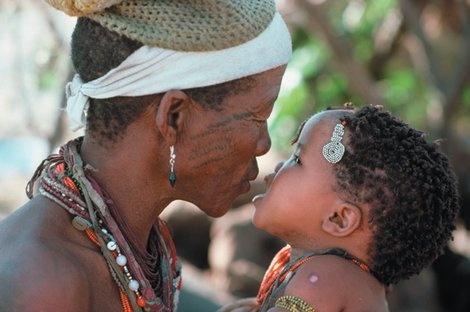The Handbook of Cross-Cultural Developmental Science. Vol. 1, Domains of Development across Cultures, had this to say about such childcare practices:
Community news. “Among African and Caribbean cultures, childcare routines include formal exercises to stimulate development of particular skills. To facilitate sitting, mothers hold newborns on their laps and support them round their waists ((J. Kilbride and Kilbride, 1975; P. Kilbride, 1980). When infants are 3 months of age, mothers sit them on the floor, supported by a hole in the ground, a mound of sand, a basin with cloth” (Super, 1976). The child responds with stepping movements, sometimes “walking” up the adult’s body (Hopkins, 1976).
When children can support their own weight, mothers prop wrapped around the hips, or propped with a cushion, mothers stand children in their laps and bounce them vigorously in a routine the Kenyan Kipsigis call “kitwalse,” meaning “to make jump” (Super, 1976). The child responds with stepping movements, sometimes “walking” up the adult’s body (Hopkins, 1976). When children can support their own weight, mothers prop them against stools (Bril, 1986b), hold their hands and encourage them to take steps. (Hopkins, 1976) Novice walkers are lured with bits of food (Konner, 1977). … In addition to formal training, informal handling also facilitates the development of reaching, sitting, crawling, and walking by holding or placing children in positions that give them opportunities to practice manual, prone, and upright skills. French infants, for example, spend 50%-60% of their day lying down (Bril, 1997).
In contrast, infants in Uganda, Botswana, and Mali spend 40%-90% of their day in sitting or standing positions (Ainsworth, 1967; Bril and Sabatier, 1986; Konner, 1977; Super, 1976). Riding in a sling on the hip or back of an active adult provides vestibular, visual, and proprioceptive stimulation. A typical woman in Mali bends down 1.5 times per minute to prepare food or tend to the fire (Bril, 1986b). Carrying also facilitates the development of muscle strength and coordination because infants must continually adjust their posture to the movements of the caregiver (Bril and Sabatier, 1986). Carried in a sling can confer additional advantages for manual exploration. Kung mothers of Botswana, for example, wear decorative objects and beads around their necks. Infants grasp onto these beads to stabilize their mouth on the breast while feeding, and they swipe, grasp, and manipulate the beads and dangling objects throughout the day, like American infants would play with a mobile or crib toy (Konner, 1972)”.
Cross cultural research on motor development found that many of the exercise routines practiced on babies in Africa and the Diaspora have the purpose of facilitating and accelerating an infant’s motor development. The book continues:
“Actual experiments with random assignment to training and control groups confirm the facilitative effects of exercise and handling. Like the formal training routines in African and Caribbean cultures, experiments showed that a few minutes of stimulation per day distributed over a few weeks is sufficient to accelerate the timing of motor skills. Four weeks of vestibular stimulation (20 biweekly spins in an office chair) resulted in higher scores for infants on the Denver Develop-mental Screening Test compared with infants who were not spun (Clark, Kreutzberg, and Chee, 1977).
Eight weeks of passive exercise (20 minutes of daily leg pumping) resulted in higher scores on the Gesell scale compared with controls who did not receive exercise (Porter, 1972). Three weeks of training in crawling (moving infants’ limbs in a crawling position for 30 to 45 minutes per day) resulted in higher scores on the Bayley scale and more advanced crawling skills compared with infants who were handled but not trained in crawling (Lagers-petz, Nygard, and Strandvik, 1971). Eight weeks of training in upright stepping (12 minutes per day) resulted in more stepping movements, retention of the stepping pattern for longer periods, and earlier onset of walking compared with infants who were passively exercised or did not receive exercise (P. R. Zelazo, Zelazo, and Kolb, 1972b).
The experimenter’s own son, Philip, was exercised beyond the 8-week cut-off, and he began walking at 7.5 months (P. R. Zelazo, Zelazo, and Kolb, 1972a). Experimental evidence also indicate that training effects are specific to the skills receiving practice, rather than generalized precocity as the result of training, (N. A. Zelazo, Zelazo, Cohen, and Zelazo, 1993)”.




